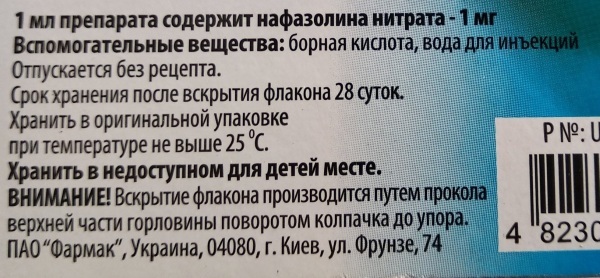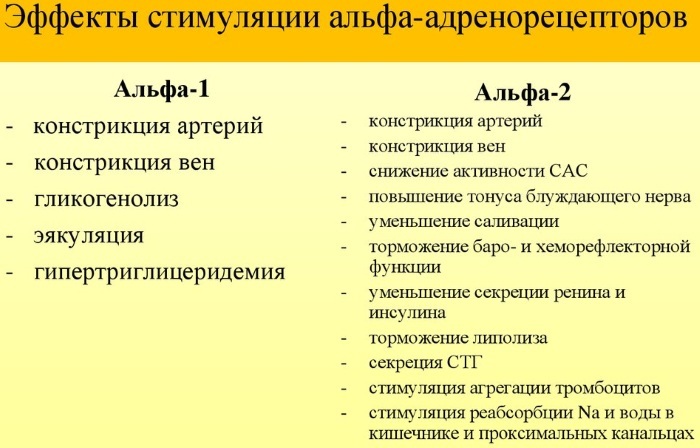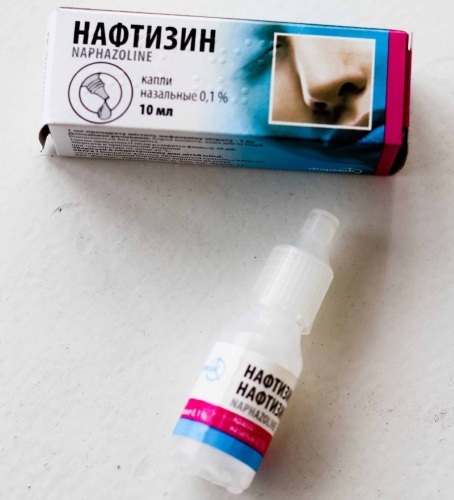Naphtizin is drops of the local spectrum of action, which are used for insertion into the cavity of the nasal canals. This drug has a pronounced effect on alpha-adrenergic receptors and the walls of the smallest vessels of the capillaries.
Naftizin drops are used in combination with other anti-inflammatory and antiseptic drugs of drug therapy. The price of the medicinal product ranges from 13.60 to 15.20 rubles. for 1 bottle, which makes it affordable for most citizens.
Record content:
- 1 Forms of release and composition of the drug
- 2 Pharmacological properties
- 3 Pharmacodynamics and pharmacokinetics
- 4 Indications for use
- 5 Contraindications
- 6 At what age can the drug be used?
- 7 Instructions for use, dosage
- 8 Side effects
- 9 Overdose
- 10 special instructions
- 11 Drug interactions
- 12 Analogs
- 13 Terms, conditions of sale and storage
- 14 Price
- 15 Video about Naphtizin
Forms of release and composition of the drug
Naphthyzine is a drop for instillation into the nose, which contains a minimum amount of chemical compounds. The table below lists the components of this drug that ensure the implementation of its pharmacological properties.
| Components of drops of Naphthyzin | Characterization of chemical components |
| Naphazoline | Naphazoline is the active substance of Naphthyzine nasal drops, which has a vasoconstrictor effect. This chemical compound is characterized by a high degree of absorption and bioavailability in the composition of blood plasma. In drops, Naphtizin is presented in a dosage of 1 and 0.5 mg, depending on the form of release of the medication. |
| Boric acid | Boric acid is an auxiliary component of drops, which serves as a safe preservative for chemical etiology. This substance stabilizes the composition of the preparation, prevents its disintegration into fractions during long-term storage. An indirect property of boric acid is the provision of a pronounced anti-inflammatory effect. This is especially true for patients with diseases of the inner ear and paranasal sinuses. |
| Water for injections | Sterile water for injection is an excipient of Naphthyzin drops, which is a universal solvent. In the production process of this drug, water is used, which has undergone special training and preliminary purification from mineral salts. |

Naphthyzin is nasal drops, which are available in glass and plastic bottles with a capacity of 10 ml, and also have an affordable price. The introduction of the drug into the cavity of the nasal openings is carried out using a special pipette, which must be purchased separately, or through the dispensing cap.
This drug is produced with an active substance concentration of 0.05% and 1%. Naphthyzin drops are a completely transparent solution without a specific odor, which has a bitter taste. The main packaging of the medication is a box made of thick cardboard. Naftizin nasal drops are completed with detailed instructions for their use.
Pharmacological properties
Nasal drops Naphthyzin is a drug that acts on the mucous membrane and epithelial tissues of the nasal canals directly in the area of its application.
This medication has the following pharmacological properties:
- contributes to the narrowing of the blood vessels of the capillaries, the walls of which are dilated as a result of acute or chronic inflammation of an infectious or allergic nature of origin;
- eliminates signs of nasal congestion, regardless of the etiology of the pathological process;
- provides quick removal of mucous contents localized in the paranasal sinuses and eustachian tubes of the inner ear;
- dries up the mucous membrane of the nasal canals, which prevents the development of pathogenic microflora;
- has an anti-inflammatory effect (this property of nasal drops Naphthyzin is manifested especially brightly when used simultaneously with antiviral, antibacterial and antimycotic means);
- prevents the formation of polyps and ulceration of the nasal mucosa caused by chronic rhinitis;
- accelerates the recovery process of the upper respiratory tract affected by infectious microorganisms, or inflamed as a result of prolonged hypothermia;
- helps to suppress the symptoms of an allergic reaction in the form of itching, burning, redness of the mucous membrane of the nasal canals, epithelial tissues located in the circumference of the nostrils.
Naphthyzin - nasal drops (the price of the medication does not exceed 15.50 rubles. for 1 bottle), which are created for symptomatic therapy.
This medication is intended to be used for a short period of time to relieve pathological signs of the underlying disease in the form of colds, flu, ARVI, acute allergic reactions. With prolonged use of drops, the pharmacological properties of Naphthyzin become less pronounced, which indicates the development of drug addiction.
Pharmacodynamics and pharmacokinetics
Pharmacodynamics of nasal drops Naphthyzine is directly related to the active component of this drug in the form of naphazoline. After the medicinal solution of this medication enters the nasal mucosa, and also penetrates into deep layers of epithelial tissues, saturates the bloodstream, starts the stimulation process alpha adrenergic receptors.
The result of this physiological process is the narrowing of the capillary walls and the simultaneous expansion of the excretory canals located in the paranasal sinuses.
Patients receiving symptomatic therapy with Naphthyzine note the elimination of signs of nasal congestion, swelling of the mucous membrane of the upper respiratory tract, itching and burning sensation.
The therapeutic effect of complete restoration of nasal breathing is achieved. The evacuation of mucus, localized in the nasal canals and paranasal sinuses, prevents the creation of a favorable environment for the development of pathogenic microflora.
This pharmacodynamic feature of Naphthyzin is especially relevant for patients suffering from chronic rhinitis of allergic etiology. The active component of this drug helps to reduce the inflammatory process in the inner ear and the Eustachian tube, and also stimulates the outflow of mucous exudate.
Pharmacokinetics of nasal drops Naphthyzin is characterized by the local action of their active component. After application of the medicinal solution to the nasal mucosa, naphosaline is rapidly absorbed. This substance quickly penetrates into the epithelial tissues of the upper respiratory tract and saturates the bloodstream.
The therapeutic effect of Naphthyzin occurs within 5 minutes. after injecting it into the nasal cavity. The active substance of the drug has a high biological activity and interaction with blood plasma proteins.
The pharmacological properties of nasal drops persist for 4-6 hours after applying a single dose. Then reuse of Naphthyzin is necessary. In the event that the main cause of rhinitis, irritation and nasal congestion has not been eliminated, then the pathological symptoms may return again.
The metabolism of naphosaline occurs in the liver tissues, and about 90% of its decay products are utilized by the body in the urine. The rest, together with bile, enters the gastrointestinal cavity, and then is excreted along with the feces.
Indications for use
Naphthyzine - nasal drops (the price of the drug is affordable for most patients with medium and low income), which are used to treat children, adult men and women, and the elderly patients.
This drug is indicated for use in the following clinical cases:
- acute and chronic rhinitis caused by an allergic reaction, viral, bacterial or fungal microorganisms;
- swelling of the mucous membrane and epithelial tissues of the nasal canals, paranasal sinuses and inner ear;
- preparation of the upper airway before performing a diagnostic test or surgery (in this case the nasal canals and paranasal sinuses are cleared of mucous contents, pathogenic microflora, the effect of drying the internal shell).

A prerequisite for the use of Naphthyzin nasal drops is to undergo a preliminary examination of the body with establishing the causes of an attack of acute or chronic rhinitis, edema of the upper respiratory tract, itching and burning inside nasal passages.
The appointment of this drug should be performed by an otolaryngologist, therapist or pediatrician (if symptomatic therapy is indicated for the child). Children aged 3 to 5 years who are being treated with Naphtizin should be supervised by adults or medical personnel.
Contraindications
Naphthyzin - nasal drops (the price of the drug is much lower than that of drugs with similar properties), which are distinguished by a simple and safe chemical composition.
Despite this, this medication is contraindicated for therapeutic use in the following cases:
- inflammation of the lining of the nasal canals without signs of excessive accumulation of mucus, and with the presence of symptoms of its increased dryness (in this case, the use of Naphthyzin will provoke the effect of even greater drying, which will lead to the formation of cracks, irritation and ulceration);
- individual intolerance to the constituent components of nasal drops, which manifests itself in the form of an acute allergic reaction;
- severe infectious diseases of the upper respiratory tract, which require the use of more potent antibacterial and anti-inflammatory agents.
Naftizin nasal drops are not recommended for use during pregnancy and breastfeeding. Patients with signs of allergic rhinitis origin need to eliminate the source, provoking irritation of the mucous membrane, and then arresting pathological symptoms in the form nasal congestion.
At what age can the drug be used?
Naphthyzin - nasal drops (the price of the medication is low), which are approved for use in children aged 3 years and older. For patients of this category, a separate dosing regimen is established.
The use of this drug is contraindicated in a young child, as there is no laboratory evidence of its safety. A sensitive child's body can react with an acute allergic reaction and side effects.
Instructions for use, dosage
Nasal drops Naphthyzin should be used in compliance with the following rules for their introduction into the nasal cavity:
- Take a horizontal position.
- Throw your head back over your shoulders. To ensure a natural slope during the drainage of the medicinal solution.
- Alternately, first drip the left and then the right nostril.
- Lie down for 10-15 minutes, massaging the nose with the fingers of your free hand. This will distribute the droplets evenly and also prevent them from flowing out.

In the case of instillation of the drug, while in an upright position, you must tilt your head back as far as possible, since part of the medication may leak out, and the expected therapeutic result will not be achieved.
The dosage of the drug and the concentration of the drug solution depends on the age of the patient. Adults, as well as children over 15 years old, 1-3 drops of the drug in each nostril.
The mass fraction of the active substance in the composition of Naphtizin drops should be 0.05 or 0.1%. Children, whose age is from 3 to 6 years old, should use the drug with a concentration of 0.05%, and its introduction is carried out in 1-2 drops in each nostril.
A child of the age group from 6 to 15 years old is shown the use of 2 drops of Naphthyzin in each nasal opening. In all cases, without exception, this medication is used 3 times a day, but the total interval between the use of the drug should be at least 4 hours. Otherwise, the risk of overdose and side effects increases.
Adult men and women, as well as the elderly, can undergo symptomatic therapy with Naphthyzin for 5 days. Children are allowed to use this drug for no longer than 3 days. Longer treatment
Naphthyzine can lead to the development of negative consequences in the form of local irritation of the nasal mucosa, the occurrence of allergic reactions, and drug addiction.
Reapplication of these drops is possible only after a break of 3-5 days. Patients who are shown to use Naphthyzine in preparation for diagnostic procedures or surgical intervention, must thoroughly cleanse the nasal passages of mucus, and then add 3-4 drops of this to each nostril drug.
The concentration of the active substance can be 0.05 or 0.01%. In case of swelling of the tissues of the larynx, which caused dysfunction of the head ligaments, it is necessary to inject 1-2 ml of Naphthyzin solution using a disposable sterile syringe. To stop nosebleeds, a cotton swab soaked in this drug of 0.05% concentration should be used, which is injected into each nostril for 1-2 minutes.
Side effects
Subject to all the rules for dosing the medication, as well as other rules of the instructions for use, Naphtizin is well tolerated by most patients of all age categories.
In isolated cases, the following side effects may occur:
- allergic reactions in the form of irritation of the nasal mucosa, redness of epithelial tissues, itching, rash;
- swelling of the tissues of the larynx, causing an attack of suffocation;
- the occurrence of severe nasal congestion, which appears immediately after the cessation of the therapeutic the action of drops (on average, this effect occurs 4-6 hours after the last instillation drug);
- tremor of the fingers of the upper extremities;
- attacks of severe headache;
- increased agitation and nervousness;
- tachycardia, a feeling of rapid heartbeat and other disturbances in rhythmic activity;
- hyperactivity of the sweat and sebaceous glands (the patient may experience profuse cold sweat when the ambient temperature is comfortable enough);
- drug addiction to the active substance of the drug, which is manifested by the occurrence of edema of the nasal mucosa, which appears immediately after the introduction of drops.
Prolonged use of Naphthyzin can cause drying out of the inner membrane of the nasal canals, as well as the occurrence of irreversible changes in its structure.
The development of inflammation of the mucous membrane, the formation of cracks and non-healing ulcers is not excluded. The occurrence of any side effects requires immediate discontinuation of the drug, as well as examination by a general practitioner or otolaryngologist.
Overdose
In case of overdose or accidental ingestion of a large amount the medicinal solution of Naphthyzin, the following symptoms of intoxication may occur:
- heart attack;
- arrhythmia;
- nausea;
- diarrhea;
- discharge of vomit;
- increased nervousness;
- cramping pain inside the abdominal cavity;
- pallor or cyanosis of the skin;
- increased blood pressure;
- tachycardia;

- drop in body temperature;
- drowsiness and general loss of strength;
- sudden cardiac arrest with the onset of biological death;
- headache;
- unstable psycho-emotional state;
- depression and depression;
- mental disorders, accompanied by depression of the central nervous system;
- coma;
- manifestation of local allergic reactions.
Patients with signs of an overdose with Naphthyzin drops should be immediately taken to the hospital. The main direction in the treatment of patients in this category is gastrointestinal lavage and intake of sorbent preparations. If the heart rhythm is disturbed, shock and coma occur, urgent resuscitation measures are performed in relation to the patient.
special instructions
Naphthyzin drops should be used with extreme caution in patients who have chronic diseases of the cardiovascular system, diabetes mellitus, hyperthyroidism of the thyroid gland, there is an increased sensitivity of myocardial tissues in relation to drugs from the group sympathomimetics.
Long-term use of the medication can provoke the opposite effect, cause permanent nasal congestion and lead to atrophy of the mucous membrane. The use of Naphthyzine in therapeutic doses is not able to affect the reaction rate and concentration. An overdose of medication can provoke drowsiness and dizziness.
Drug interactions
The simultaneous use of drops of Naphtizin with Maprotiline, MAO inhibitors, as well as antidepressants of the tricyclic type, can cause a sharp increase in blood pressure.

A similar reaction of the body can be observed even if these medications are taken 2-3 days after the end of therapy with Naphthyzin.
Analogs
The following local-spectrum drugs are presented on the pharmaceutical market, which are analogues of Naphtizin:
- nasal spray Sanorin 10 ml - 158 rubles;
- Ivilekt spray 10 ml - 250 rubles;
- Aqua Maris spray 30 ml - 228 rubles;
- drops Sinupret 100 ml - 277 rubles;
- Quicks spray 30 ml - 279 rubles.
The use of the above drugs is possible only as directed by the attending physician.
Terms, conditions of sale and storage
Naftizin drops are sold without a prescription. It is necessary to store the medication at a temperature not higher than +25 degrees. The shelf life of this drug is 3 years.
Price
The cost of drops of Naphtizin in pharmacies is from 13.60 rubles. up to 15.20 rubles. for 1 bottle with a capacity of 10 ml.
Drops Naphthyzin is a topical drug that is used for nasal instillation in adults and children. This drug is indicated for short-term use to relieve symptoms of the disease.
Naphthyzine allows you to eliminate nasal congestion, relieve swelling of the mucous membranes, and restore breathing. The maximum duration of therapy with this agent is 5 days. The affordable price and high effectiveness of nasal drops makes them popular among the general population.
Video about Naphtizin
Instructions for the use of Naphtizin for adults and children:



